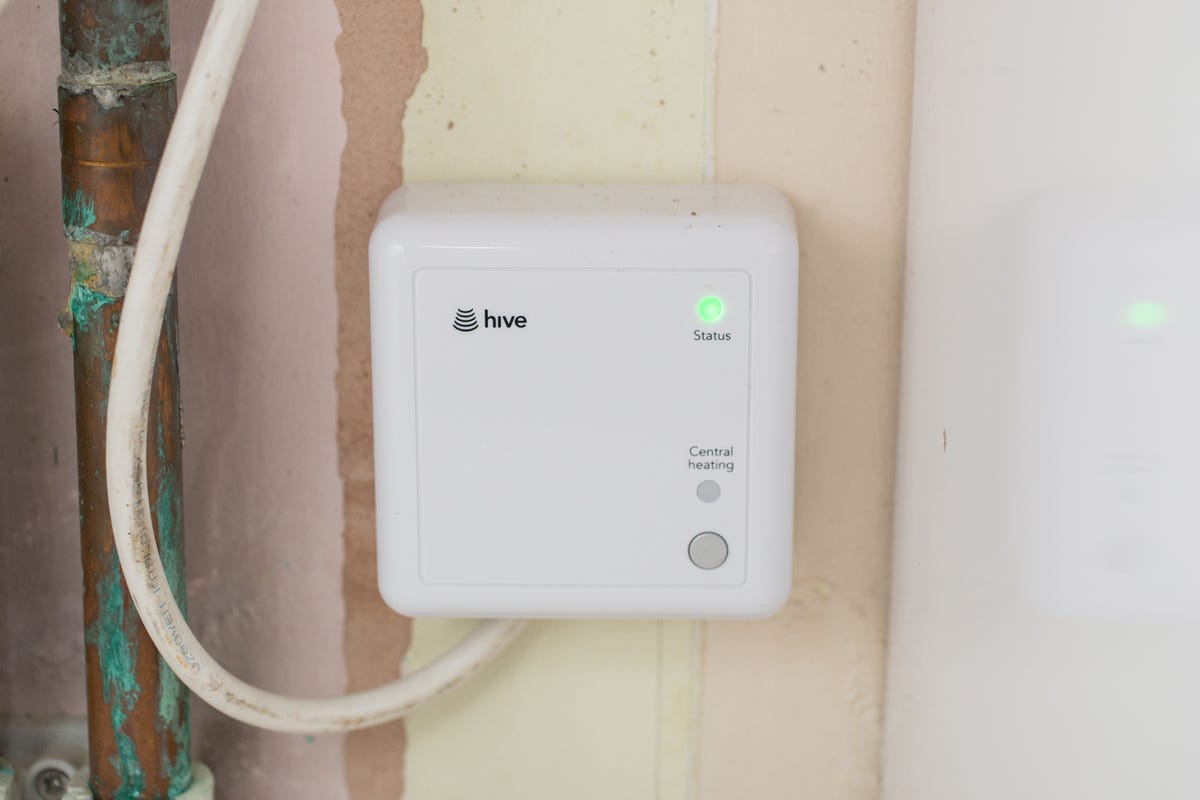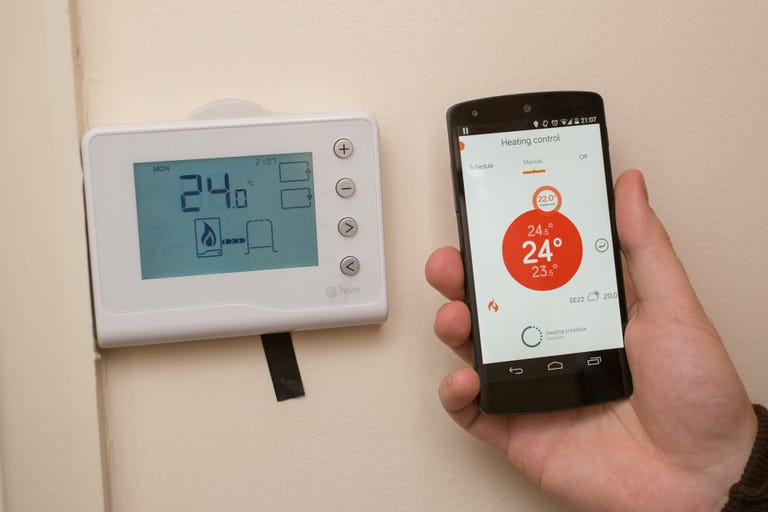 Why You Can Trust CNET
Why You Can Trust CNET British Gas Hive review: A simple app-controlled thermostat that's a delight to use
Turning on your heating while you're still in bed makes you feel a tiny bit more like you're living in the future. But is it worth £199?
Hive is British Gas' take on the Internet of Things, the idea that the Web can revolutionise even simple things in your home -- in this case, your central heating. While "Hive" might not sound like something you'd normally want in your airing cupboard, it's a simple, well designed system that makes turning on your heating much easier, and even kind of fun.
The Good
The Bad
The Bottom Line
It comes in four parts: a little receiver, which an engineer wires into your boiler; a new wireless thermostat; a hub, which plugs into your Wi-Fi router; and an app for your phone or tablet to control the whole thing. Hive works with gas, LPG and oil-type central heating systems.
It costs £199 including installation, and there's no need to be a British Gas customer. I'm not, I'm with ScottishPower (which has its own similar system called Connect), and you may be relieved to hear British Gas has not pestered me with emails or junk mail. Other systems are available, most notably the Google-owned Nest Learning Thermostat , which you can get on a deal with npower.
Installation
Pay your £199 and British Gas sends a nice man or woman round to wire the thing up and show you how it works. A small white box sits on the wall under your boiler, and effectively replaces whatever timer the system has built in. It took about half an hour for the wiring and explaining, and then another half an hour while he worked out a problem with the hub failing to connect to the boiler. My flat, it turns out, is a black hole for wireless reception and he had to plug a booster unit called a SmartPlug into a wall socket halfway along. That fixed it all up and there was no extra cost.

To use it, you just need a spare Ethernet port on your router. It flashes a few different colours (red when it wouldn't connect) but once running you can tuck it away behind your router and forget about it. The engineer pulled my old thermostat off the wall (it didn't work anyway) and put the new one in its place. It's battery powered and wireless, so you can put it anywhere. A little bracket sticks to the wall with pads and the unit clips in and out when you need to change the batteries.
This may be the only time I ever write this sentence, but it's a genuinely lovely thermostat. Its simple white plastic buttons may not be as fancy as Nest's knob, but its screen is easy to read and has a soothing blue glow. Good job, British Gas. You'll only need to use it if you lose your phone, or the Internet goes down, but nevertheless it's a pleasing thing to have on your wall.
The only problem I had was the app insisting the thermostat was running out of batteries when I'd just changed them. That disappeared after a few days. Oh, and once when my broadband went down, I had to disconnect and reconnect all four devices via the website.
The Hive app
Hive has apps for Android and iPhone, and a website, Hivehome.com, which is usable on a phone screen if you have a Windows Phone, for example. If you don't have a smartphone at all, well first, don't buy this, buy a smartphone, and second, you can text commands such as "HEAT ON" or "HEAT AUTO" to a central number. The apps are available for tablets too, but they're not particularly optimised for them. The iPad version just has the options always open at the side, for example, instead of swiping to reveal them.
The app is a great experience, letting you swipe up and down on a gorgeous colour-coded sphere to change the temperature at which your heating comes on. You can also switch between your heating schedule, manual control and off. Incidentally, if you set Hive to "off" it'll still come on when your house gets below 7C, to protect your pipes.
It's completely self-explanatory and a pleasure to use. There's no social-media gimmickry -- it doesn't ask you to tweet your home temperature or share your heating schedule on Facebook -- and there are no ads. It's free to download, of course.
Having the power to control your heating in your phone takes a weight off your mind, I found. Rushed off on holiday and forgot to turn the heating off? Just use the app (as long as you didn't unplug your router, of course). There's also peace of mind from knowing your house will be warm when you get home, because you can tell it to warm up as you're leaving work.
The real value I get out of it, on a regular basis, is not having to get up to turn the heater on. If it gets chilly when you're snuggling in bed on a Sunday, or in front of the TV in the evening, you don't have to get up or stop what you're doing, you just open the app. It's the kind of glorious laziness we were promised the future was going to involve.
Geolocation
The only other feature is "geolocation". That means you tell it when you're at home and when you go beyond a certain boundary (700 feet, or 210 metres, by default) it pops up a notification if your heating is set above 10C, which again you can adjust. Then when you return to within a certain radius (1 mile by default) it notifies you if your heating is below a certain level, in this case 20C.
I turned it on and left the house with the heating on, on purpose, and it dutifully pinged me. The return feature worked too, but then I work a significant distance away from home -- if you work in the same neighbourhood, or return to the area at night but go out to dinner, you'd probably find it turning on your heating when you didn't want it to. I also found it notified me asking if I wanted to check my home's temperature, which was annoying and completely pointless, so I turned it off.
Does it drain your phone battery? My Nexus 5 normally has about 15 percent battery left when I go to bed, and I didn't notice any significant deterioration after I turned the geolocation feature on.
Scheduling
If you want to change your schedule, however, Hive's full website is much easier to use than the app. The site lets you set periods of the day using sliders, and a temperature for each period, which is much easier than the app's tumblers and "events". You can copy a day across to the next, which makes it simple to do Monday to Friday as all the same and then Saturday and Sunday differently.
If, like me, you've always had to schedule your boiler one day at a time on an analogue dial, this is a godsend. It has the potential to save you real money. If you're always out on Wednesday nights, at a class for example, you no longer have to remember every Wednesday morning to change the heating to come on later.
Hive doesn't have the predictive smarts of Nest, which "learns" how warm you like your house and can sense when you've come home. But Nest doesn't have the ability to sense when you're coming home and warm up the house, it just has to guess based on your behaviour. So which is better for you probably depends on your routine -- are you home at the same time every day, regular as clockwork? Then Nest is for you. If you're out and about at different times, Hive probably has the edge.
Does Hive save you money?
British Gas says Hive can save you up to £150 on your heating bill, although it gives no evidence to support that. I compared my bills from ScottishPower to last year's. For the only period available that was fully covered by Hive, from February to May, I used 2,625kWh. That's a saving of nearly 18 per cent on the 3,186kWh I used the year before. This year's figures included a week when I was on holiday, however. More importantly, according to Accuweather, London was significantly cooler in that period last year -- 3-5C colder on average -- so I would expect to have used more gas.
I don't think I can say with any confidence that Hive contributed to my lower gas bill. I'd have to see several years' worth of data to really make that connection, and preferably compare several homes.
For context, I live in a two-bed flat in the ground floor of a Victorian terrace, with no double glazing. So we have a lot of neighbouring walls to keep the heat in, but probably lose most of that benefit through poor insulation.
Conclusion
Hive lets you turn the heating on from your sofa, which is a bit like living in the future. Setting different schedules for different days of the week is a huge bonus too, but that's really all there is to it. If, like me, you have a fiddly boiler and your thermostat doesn't work, this is a terrific upgrade.
For most people though it's a luxury -- and if you're going to waste money on something like this, you might as well get the coolest one, which is definitely Nest. Nest is only £50 more and has more "learning" features to save you money, and a much cooler thermostat.


